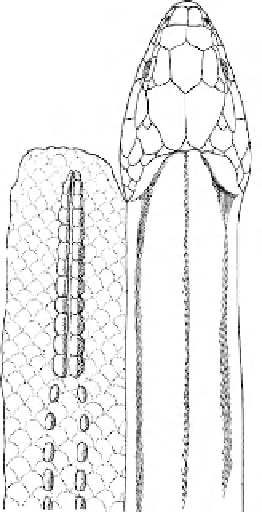Biology Reference
In-Depth Information
Figure 4.2
The dorsal-nuchal glands of the green keel-back (
Macropisthodon
plumbicolor
).
The well-known physician-herpetologist, Malcolm Smith (see also Plate
4.31C), drew this rendering of the unusual glands of
M. plumbicolor
. These appear similar
to those of the hazard level 1 colubrid, the tiger keel-back or yamakagashi (
R. tigrinus
).
The
R. tigrinus
nuchal glands produce several novel polyhydroxylated steroid toxins, the
bufadienolides. Unlike the toxins present in Duvernoy's glands, these toxins are formed
from dietary precursors. Although the
R. tigrinus
glands seem to provide an antipredator
armamentarium, the function and components of the
M. plumbicolor
glands remain unknown.
After Smith, 1938.
Similarly located glands have been described by Smith (1938) in the Asian green
keel-back,
Macropisthodon plumbicolor
(Plate 4.14A;
Figure 4.2
). Neither their
function or biochemical properties of their secretion(s) have been investigated.
4.3.2.3 Overview of the Properties, Toxinology, and Pharmacology of Venoms
of
R. subminiatus
and
R. tigrinus
There are few data regarding venom yield from these snakes. Using micropipette
extraction, Ferlan et al. (1983) obtained 10-15 μL of secretion from
R. subminiatus
.
Although solid yield was not reported, they detected 14.34 mg protein/mL secretion
(Ferlan et al., 1983). Excision, maceration, and extraction of Duvernoy's glands from
R. tigrinus
yielded 8.5-20.5 mg solids (Sakai et al., 1983).
As noted with
Dispholidus
and
Thelotornis
(see previous section), significant
envenomation from either
R. tigrinus
or
R. subminiatus
often presents the physician

